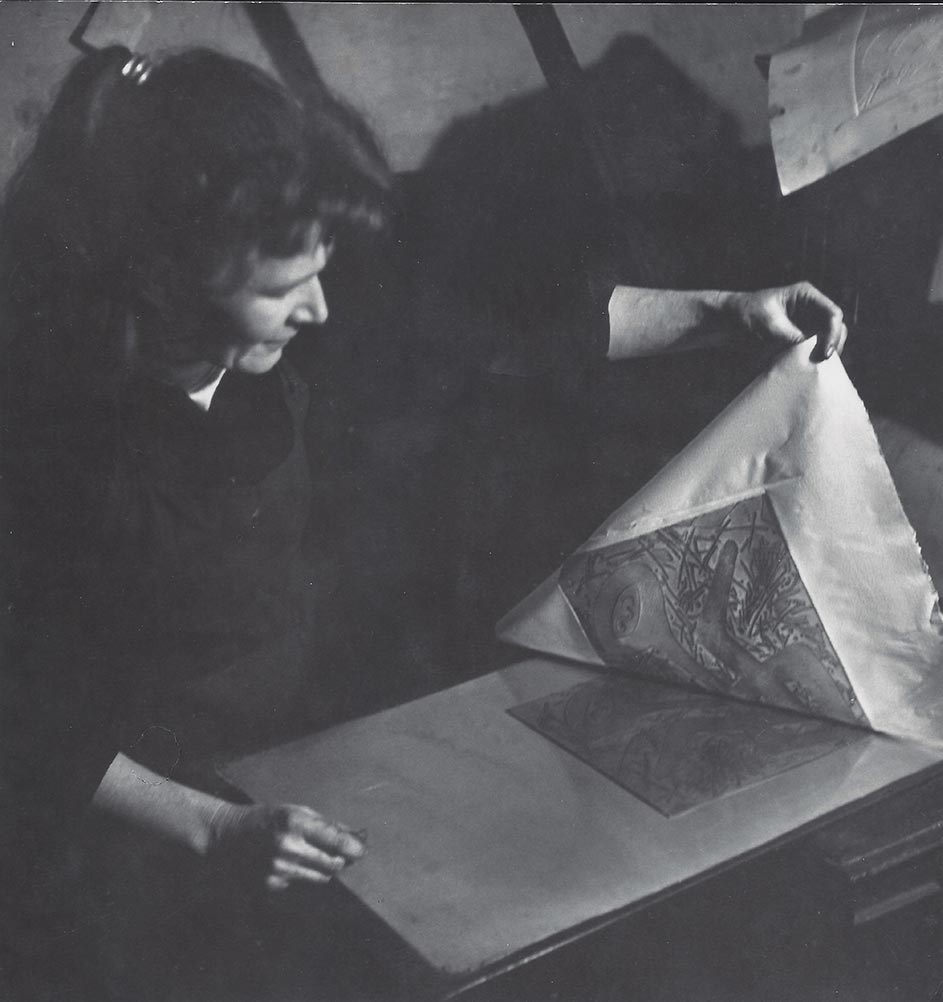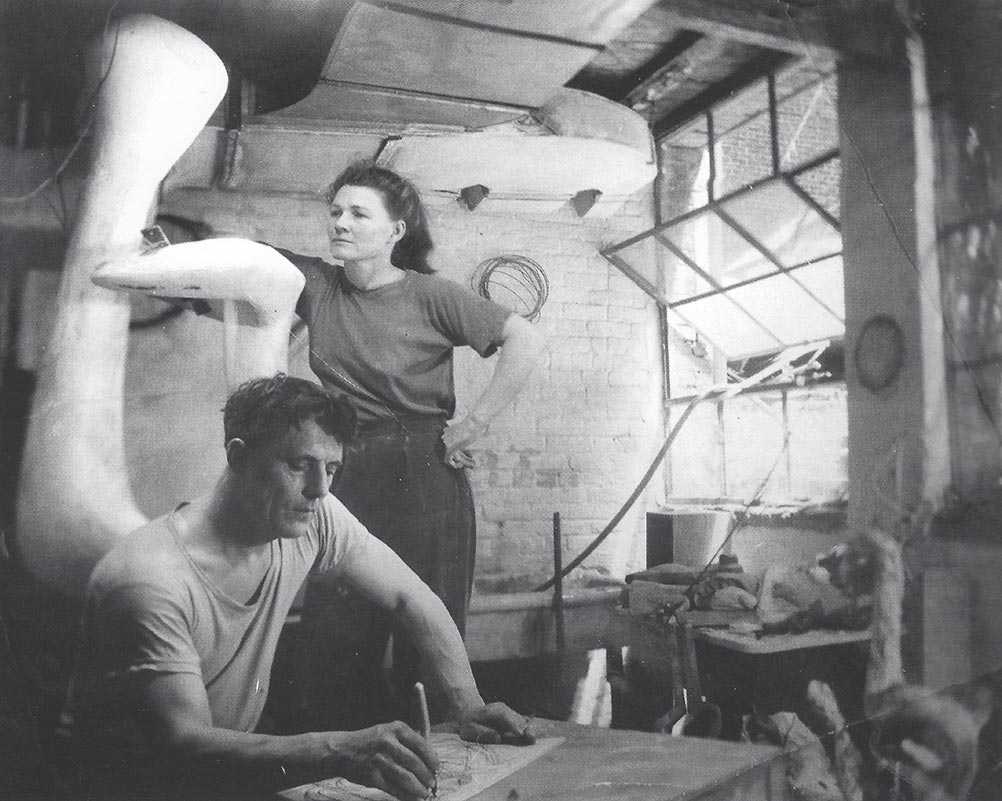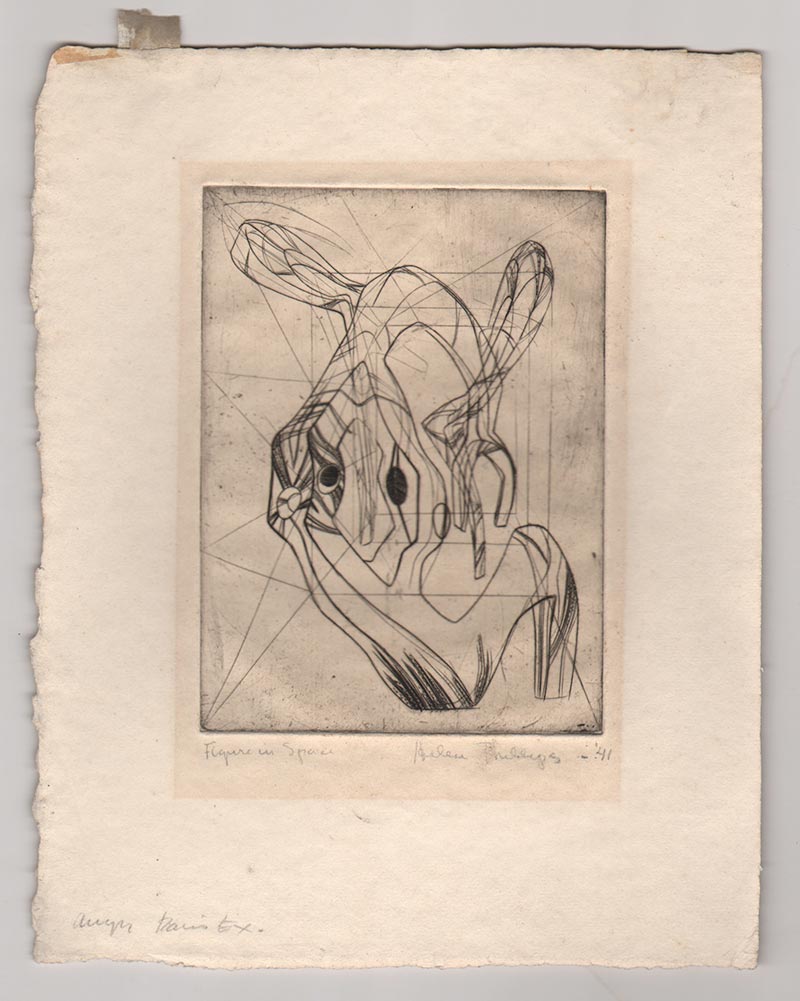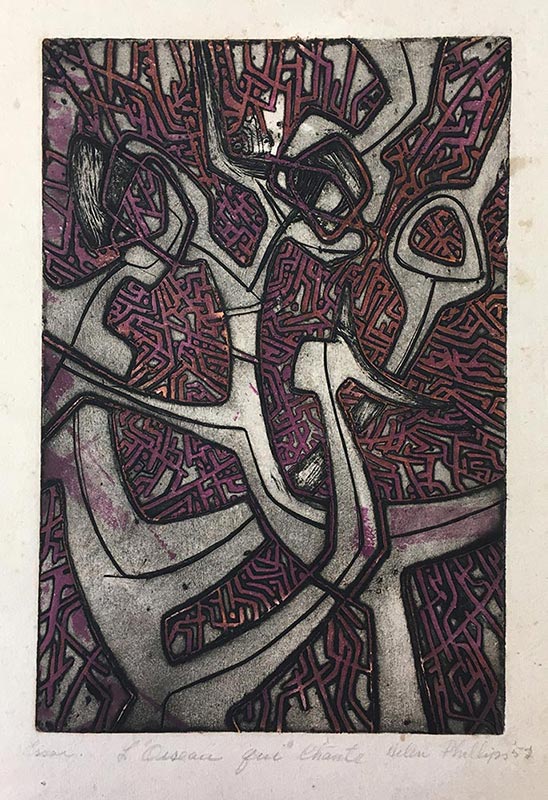72. Helen Phillips
| Life Dates | 1913-1995 |
| Place of Birth | Fresno, CA, USA |
| Place of Death | New York, NY, USA |
| Birth Name | Helen Phillips |
Born in Fresno, California, Helen Phillips commenced art studies at the age of fifteen at the California School of Fine Arts (now the San Francisco Art Institute) and enrolled there full-time in 1931, learning direct carving with Robert Stackpole. She had a banner year in 1936: she won a purchase prize from the San Francisco Museum of Art (now SFMOMA) for her stone sculpture Young Girl and received the Phelan Traveling Fellowship from the San Francisco Art Association, which provided $2,000 for travel abroad.1 She spent three years in Paris—summer 1936 until the outbreak of war in 1939—where she interacted with the surrealists, discovered Atelier 17, and met her future husband, Stanley William Hayter. Phillips was attracted to the sculptural qualities of engraving and liked that printmaking allowed her to experiment more quickly than sculpture.2 The experience of incising copper with the burin sharpened her understanding of positive and negative spaces and altered the way she dealt with sculptural volume. Of the roughly twenty-five plates she produced in Paris, many feature biomorphic forms and headless stick figures—a recurring form she described as “two joined wishbones” and which suggests motion and dance. While living in New York during the 1940s, Phillips maintained a studio in the family’s brownstone and exhibited her sculpture in important exhibitions, but she regretted not having more time to work regularly at Atelier 17.3 Her engraving Figure in Space (1941, alternately titled Figure in Box), which reflects her sculpture’s sinuous, twisting limbs, was exhibited in New Directions in Gravure at the Museum of Modern Art, New York, in 1944. Phillips earnestly resumed printmaking activity during the 1950s, once her family resettled in Paris, and produced many deeply carved plates printed using the workshop’s signature color viscosity process.4 Phillips and Hayter divorced in 1972, and she made sculpture well into the 1970s, but shifted to working in wire, plaster, and wax after a severe back injury hampered her in the late 1960s.
Archives
Helen Phillips papers, Paris, France.
Selected Bibliography
Clarac-Sérou, Max. Cuivres Gravés et Sculptés Par Helen Phillips. Paris: La Hune, 1954.
Cohen, David. “Obituary: Helen Phillips.” Independent, February 17, 1995.
Dungan, H. L. “San Francisco Art Association’s 56th Annual Opens in S. F. Museum.” Oakland Tribune, February 2, 1936.
Fort, Ilene Susan, Teresa Arcq, and Terri Geis, eds. In Wonderland: The Surrealist Adventures of Women Artists in Mexico and the United States. Los Angeles: Los Angeles County Museum of Art; DelMonico/Prestel, 2012. Biographical entry, p. 234.
Giedion-Welcker, Carola, and Bernard Karpel. Contemporary Sculpture an Evolution in Volume and Space. New York: Wittenborn, 1960.
Hartman, Ferris. “Three Musketeers of French Sculpture.” San Francisco Chronicle, June 8, 1958.
“MCA Buys Three Sculptures.” The Dallas Morning News, September 18, 1960, sec. 5.
“Montalvo’s Maecenas.” Time, June 15, 1936.
Montbizon, Rea. “Prints and Sculptures by Helen Phillips.” The Gazette, October 8, 1966.
Penrose, Roland. “Jeu d’oracle.” In 4 artistes américains de Paris. Paris: Centre culturel américain, 1958.
Polley, E. M. “Works of Hayter, Phillips on Display.” Vallejo Times-Herald, May 13, 1956.
Prints by Stanley William Hayter and Helen Phillips. San Francisco: Achenbach Foundation for Graphic Arts, 1956.
Robillard, Yves. “Phillips: Des Sculptures Surréalistes.” La Presse. September 1966.
“S. F. Sculptress Wins \$2,000 Trip Abroad,” June 1936.
Sharp, Marynell. “Man and Wife.” Art Digest 24 (October 1, 1949): 12.
“She’ll Travel Now: Girl Sculptor Awarded Trip.” Oakland Tribune, June 3, 1936.
“Young Americans: Helen Phillips.” American Magazine of Art 29, no. 8 (August 1936): 532–33.
Notes
- News of both awards earned coverage in local and national press: H. L. Dungan, “San Francisco Art Association’s 56th Annual Opens in S. F. Museum,” Oakland Tribune, February 2, 1936, 79; “She’ll Travel Now: Girl Sculptor Awarded Trip,” Oakland Tribune, June 3, 1936, 6; “S. F. Sculptress Wins $2,000 Trip Abroad,” San Francisco Chronicle, June 1936; “Montalvo’s Maecenas,” Time, June 15, 1936; and “Young Americans: Helen Phillips,” American Magazine of Art 29, no. 8 (August 1936): 532–33. ↩
- Helen Phillips, interview by David Cohen, May 4, 1989, Helen Phillips papers, Paris. ↩
- Phillips remembered hosting New York studio members for coffee at her home on Waverly Place: “I knew much of what was happening in the workshop, although I hadn’t the time and baby-sitters necessary to work there regularly.” Helen Phillips to Fred [Becker], n.d., HPP. Among the more important sculpture shows were: The Women, Art of This Century (1944); Bloodflames, Hugo Gallery (1947); Sculpture annual, Whitney Museum of American Art (1948); and Artists: Man and Wife, Sidney Janis Gallery (1949). ↩
- Many were exhibited in Prints by Stanley William Hayter and Helen Phillips (San Francisco: Achenbach Foundation for Graphic Arts, 1956). ↩



